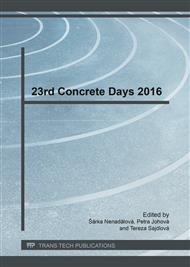p.113
p.119
p.125
p.130
p.135
p.140
p.146
p.152
p.158
Shear Resistance of Slabs Subjected to Concentrated Loads
Abstract:
Shear resistance of reinforced concrete members without shear reinforcement is a discussed topic because of its brittle character of failure. Bridge slabs subjected to concentrated loads have the ability to distribute local loads in transverse direction, which contributes to their shear resistance. Verifications used in the past (based on theory of allowable stresses) provided much higher shear resistance than currently valid EC2. This often leads to requirements of shear reinforcement in areas where it wasn’t necessary in the past. This also brings up the question of reliability of existing structures.Multiple experimental campaigns at several European universities have been carried out in past years with the intention to verify the real resistance of slabs subjected to concentrated loads. The process of selecting and calibration of a new model for verification is also in progress. This paper deals with analysis of experimental results based on currently valid and new models and their comparison.
Info:
Periodical:
Pages:
135-139
Citation:
Online since:
May 2017
Authors:
Keywords:
Price:
Сopyright:
© 2017 Trans Tech Publications Ltd. All Rights Reserved
Share:
Citation:


